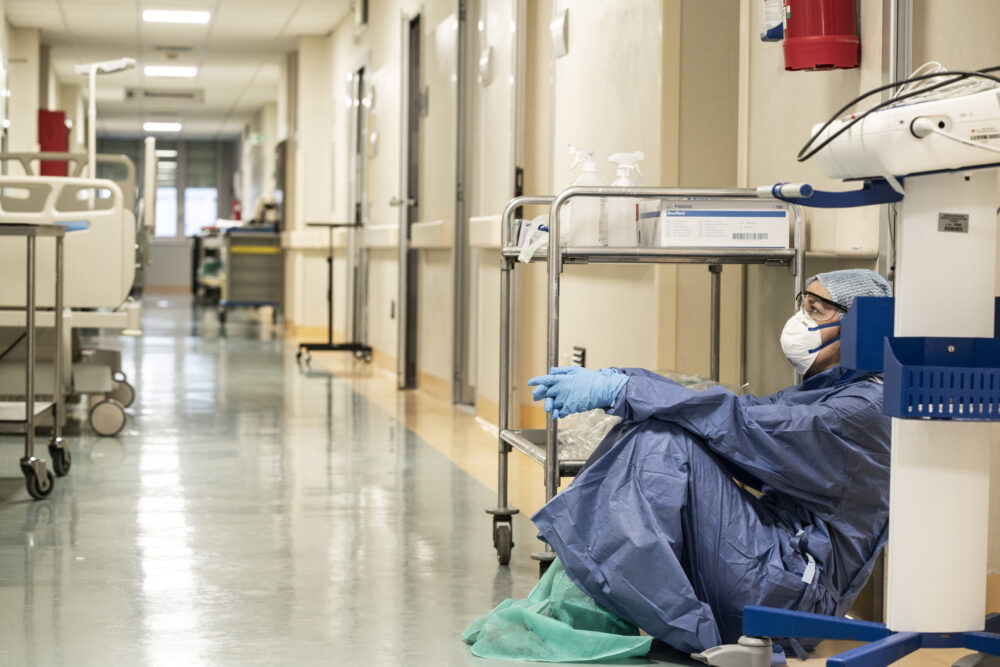They were called healthcare heroes, applauded by strangers in the streets, and given tribute at the presidential inauguration. We watched as they covered themselves in insufficient personal protective equipment and stayed with patients in their last moments. Clinicians lost sleep and risked death as they worked to save patients from COVID-19. They have faced the brunt of the pandemic and have sacrificed everything to “flatten the curve,” but yet another public health crisis looms over the world of healthcare: clinician burnout.
According to the American Medical Association (AMA), burnout is an occupational syndrome or state where an individual experiences emotional exhaustion, depersonalization or cynicism, and a decreased sense of personal achievement. The National Academy of Medicine estimates that 35% to 54% of nurses and physicians, and 45% to 60% of medical students and residents experience symptoms of burnout. The pandemic greatly raised awareness of burnout, as headlines of clinicians dying by suicide or leaving medicine entirely overwhelmed newsfeeds. However, it is important to note that burnout was only exacerbated by COVID-19; clinicians have been burnt out long before and will continue to burn out in the future if healthcare does not change.
35% to 54% of nurses and physicians, and 45% to 60% of medical students and residents experience symptoms of burnout.
Those who wish to become clinicians do so due to a desire to help people when they are sick. Being able to help people as much as they can and see patients recover is what drives clinicians to stick through tough situations. However, medicine is no longer like this. The development of the electronic health record has left clinicians spending more time on the computer rather than with their patients as billing and insurance demand excruciatingly detailed documentation. A 2017 study done by the Annals of Family Medicine found that clinicians spend about 5.9 hours out of an 11.4-hour workday simply on electronic documentation. Mistakes and errors also lead to risks of litigation, which leave clinicians subjecting patients to unnecessary tests just to be on the safe side.
As technology has progressed, patient-clinician relationships have transformed. Electronic health records limit the amount of face-to-face interactions between patients and clinicians, and patients now have more access to health information online, which leads to conflicting beliefs and ideals. With all of these unnecessary stressors, clinicians are unable to form strong bonds with patients, causing motivation and confidence to falter. It is estimated that 300 physicians die by suicide every year, and female nurses are at twice the risk for suicide as compared to the general female population. Patients also suffer as burnt-out clinicians can make more frequent medical errors and provide suboptimal care. According to the AMA, the United States health system loses about 4.6 billion dollars every year because of turnover, reduced productivity, and reduced patient safety and satisfaction.
So, if burnout is detrimental, why hasn’t something been done? Like many other things in medicine, burnout is difficult to address. The culture of medicine is one of endurance, where clinicians are expected to keep working even after watching their patient die. Because of how physically and emotionally grueling medicine is, clinicians are expected to be strong and to hide their emotions and weariness from their patients and colleagues. This culture of stoicism and endurance makes it hard for clinicians to seek help from their colleagues or leaders as they are conditioned to internalize everything so as to not appear “weak.”
It is estimated that 300 physicians die by suicide every year, and female nurses are at twice the risk for suicide as compared to the general female population.
Medical licensing and renewal are major barriers that prevent clinicians from seeking any type of mental health support. State medical boards ask licensure-seeking clinicians about their mental health, diagnoses, and treatment to determine if they need to be further examined or provide testimony; they can also trace previous usage of mental health treatment. Not only may these licensures violate the Americans with Disabilities Act, but they also intensify the stigma of mental illness within the medical community.
There is also a wide-spread misconception that clinicians themselves are to blame for burnout. Clinicians have been overwhelmed with suggestions to try yoga, do more exercise, sleep more, and to practice resilience and self-care to reduce burnout. These solutions focus primarily on the individual and suggest that it is the fault of the clinician for not being resilient enough. In reality, clinician burnout is a result of a broken healthcare system that focuses on results and numbers, rather than patients.
The stigma of mental illness is integrated into medicine to the point where clinicians feel they must choose between their careers and their mental health. While nothing like COVID-19, clinician burnout is an epidemic that is plaguing our healthcare system. But, that’s not to say nothing can be done. As more and more clinicians share their stories and demand for change and awareness, we are closer to forming an environment where clinicians feel safe enough to seek support.
The American Journal of Psychiatry Residents’ Journal (2018). DOI: 10.1176/appi.ajprj.2018.131101
The Annals of Family Medicine (2017). DOI: 10.1370/afm.2121
JAMA Psychiatry (2021). DOI: 10.1001/jamapsychiatry.2021.0141

